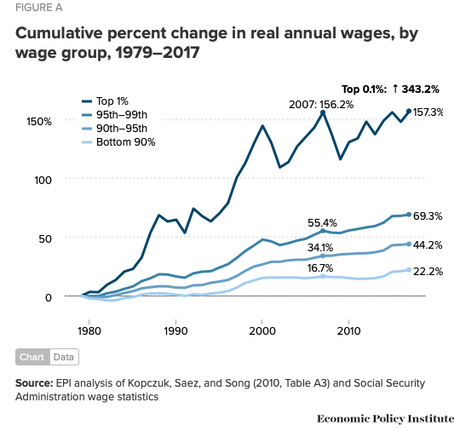
The Republicans instituted their economic policy (commonly called "trickle-down" economics) about four decades ago. And even when they didn't have majorities in Congress since then, they had enough power to keep Democrats from changing that policy.
The policy has been very good for the income growth of the rich (and especially the super-rich), but it has not been so good for most Americans (the bottom 90%). The bottom 90% have struggled just to keep up with inflation.
Here's how the Economic Policy Institute puts it:
As Figure A shows, the top 1.0 percent of earners now earn by 157.3 percent more than they did in 1979. Even more impressive is that those in the top 0.1 percent had more than double that wage growth, up 343.2 percent since 1979 (Table 1). In contrast, wages for the bottom 90 percent only grew 22.2 percent in that time. Since the Great Recession, the bottom 90 percent enjoyed very modest wage growth, with annual wages (i.e., reflecting growing annual hours as well as higher hourly wages) up just 5.4 percent over the eight years from 2009 to 2017. In contrast, the wages of the top 0.1 percent grew 29.8 percent from 2009 to 2017. . . .
These disparities in wage growth reflect a major change in the distribution of wages since 1979. The bottom 90 percent earned 69.8 percent of all earnings in 1979 but just 60.9 percent in 2017. In contrast the top 1.0 percent increased its share of earnings from 7.3 percent in 1979 to 13.4 percent in 2017, a near doubling. The growth of wages for the top 0.1 percent is the major dynamic driving the top 1.0 percent earnings as the top 0.1 percent more than tripled its earnings share from 1.6 percent in 1979 to 5.2 percent in 2017.

